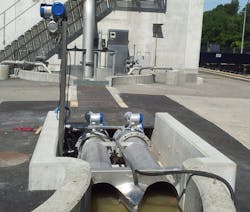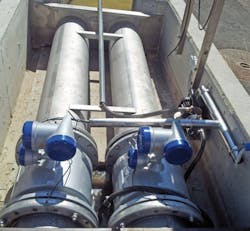Inlet flow measurement in the open channel of a sewage treatment plant
- Flow measurement for controlling mechanical preliminary clarification
- Determining volumes of sewage in partially filled gravity pipelines
- Automated dosing of precipitants using a PLC
Background:
At the inlet of the sewage treatment plant in Autigny, Switzerland the wastewater is first collected in a tank and then transported for mechanical preliminary purification via two screw pumping stations. The wastewater flows through a screen and grit chamber in an open, partially filled channel (gravity pipeline) before going on to preliminary clarification. This channel is designed for a maximum flow height of about 6 inches.
Measurement requirements:
By law, the plant must conduct an inlet measurement of the volume of wastewater flowing into the sewage treatment plant and the operator had been using a Venturi flow measurement for this. However, because this kept resulting in backflow the accuracy was deemed to be very low. Following renovations to the channel, the flow measurement ultimately stopped working altogether and this affected the entire purification process because they always dosed the precipitants for preliminary clarification based on the flow rate which was now virtually impossible to determine.
Due to the use of the screw pumping stations, flowrates in the channel fluctuate considerably from 240 to 4800 USGPM. The operator, therefore, decided to install a flowmeter at the entrance to the preliminary clarification plant for the first time. The search proved difficult due to the prevailing parameters. As the channel could not be lowered, any suitable measuring instrument had to fit into the existing infrastructure. The gravity pipeline also required a measuring solution that could be used at different fill levels.
Solution
The plant operators opted for the TIDALFLUX 2300 F for this application. It is a unique electromagnetic flowmeter for partially filled pipelines. Following intensive tests, the customer decided to use two individual instruments with a 14-inch nominal diameter which were installed beside each other in the gravity pipeline of the inlet structure located at the supply pipe to the preliminary clarification plant.
The TIDALFLUX features an integrated, non-contact capacitive level measuring system and is, therefore, designed for measurements in unpressurized sewage channels. The KROHNE instrument can reliably determine the inlet flow rate from a fill level of 10%. The polyurethane liner protects the measuring instrument against the sometimes abrasive and aggressive components in the wastewater.
Customer benefits
Thanks to the TIDALFLUX, the plant now has a reliable and - compared to the Venturi measurement – much more accurate way of determining flow rates. Not only does the plant comply with the wastewater directives; the customer can also continuously document inlet flow, but most importantly he can optimize the purification processes using a PLC as well. The precipitants can now be added according to the wastewater volumes. This means that only the precipitants that are actually needed are used, which will reduce costs in the long term. By using the TIDALFLUX, the plant operations are now more flexible and can respond more quickly to fluctuating wastewater volumes, as plant manager confirmed: "The invested time and planning have paid off. Now we can identify every gallon of flow and can thus very accurately control the purification process."


